


 |
September 7, 1987: Sailing on Lake Ray Hubbard |
 |
April 18-19, 1987: A Weekend in Seattle |
 |
Return to the Index for 1987 |
Early in July I had to make a trip to Washington to do two classes for the Army. I thought that instead of coming home to Dallas, Grant might like to come to Washington to see the sights. I arranged for him to come up on Friday afternoon after my class was over, and he was able to stay until Tuesday.
|
Alexandria is the Virginia city that lies just across the river from the District of Columbia, and it is the closest-in bedroom community for the city of Washington. Because of that, it is very upscale- and getting more so every time I come here.
North of Alexandria are National Airport and the Pentagon; the city extends south along the Potomac to the bridge that carries I-495 across the river as it circles the District. Right in the center, close to the river, is "Old Town", which, as its name suggests, is the original part of Alexandria. The history of Alexandria, Virginia, began with the first European settlement in 1695. Over the next century, the town became a significant port. In 1801, much of Alexandria was swept into the new District of Columbia; it was damaged along with much of the rest of the capital during the War of 1812. In 1846, Alexandria was returned to Virginia, along with the rest of the District's territory on the western side of the Potomac River. After Virginia seceded in 1861, Alexandria was swiftly captured by Union forces and held for the remainder of the American Civil War. In the late 20th century, Alexandria became a key part of the rapidly growing Northern Virginia region.
|
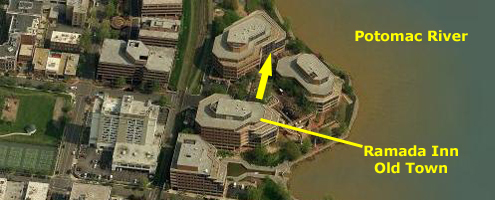 |
The Ramada Inn Old Town is part of a new development complex right on the river. I like to stay there because it is away from the crowded city; most of our classes for the Army are given at Fort Belvoir, which is south of Alexandria and consequently the traffic is much better in the morning and the evening.
The hotel is also right on the Mount Vernon jogging trail that runs about nineteen miles down the river to Mt. Vernon from the Pentagon. Grant liked the Potomac the first time he saw it, because there were a few sailboats on it. There is a marina just down the river from the hotel, and of course Grant wanted to see that. It is amazing how he can wander around like he owns the place, and usually get access to any dock he wants to. It was too late on Friday afternoon to go into the city, so after we walked along the Potomac for a while (during which time I got in some jogging on the trail), we had a nice dinner at a restaurant in Old Town Alexandria.
An Excursion to Annapolis, Maryland
|
The city itself is relatively small, with a population of about 30,000. It is, however, the epitome of "nauticalness".
A settlement in the Province of Maryland named "Providence" was founded on the north shore of the Severn River in 1649 by Puritan exiles from Virginia led by Governor William Stone (1603–60). The settlers later moved to a better-protected harbor on the south shore. The settlement on the south shore was initially named "Town at Proctor's," then "Town at the Severn," and later "Anne Arundel's Towne" (after the wife of Lord Baltimore who died soon afterwards).
|
In 1654, after the Third English Civil War, Parliamentary forces assumed control of Maryland and Stone went into exile in Virginia. Per orders from Charles Calvert, fifth Lord Baltimore, Stone returned the following spring at the head of a Cavalier force. On March 25, 1655, in what is known as the Battle of the Severn, Stone was defeated, taken prisoner, and replaced by Lt. Gen. Josias Fendall (1628–87) as fifth Proprietary Governor. Fendall governed Maryland during the latter half of the Commonwealth. In 1660, he was replaced by Phillip Calvert (1626–82) as fifth/sixth Governor of Maryland), after the restoration of Charles II (1630–85) as King in England.
|
In 1694, soon after the overthrow of the Catholic government of Thomas Lawrence, Francis Nicholson moved the capital of the royal colony to Anne Arundel's Towne and renamed the town Annapolis after Princess Anne of Denmark and Norway, soon to be the Queen of Great Britain. Annapolis was incorporated as a city in 1708.
17th century Annapolis was little more than a village, but it grew rapidly for most of the 18th century until the American Revolutionary War as a political and administrative capital, a port of entry, and a major center of the Atlantic slave trade. The Maryland Gazette, which became an important weekly journal, was founded there by Jonas Green in 1745; in 1769 a theatre was opened; during this period also the commerce was considerable, but declined rapidly after Baltimore, with its deeper harbor, was made a port of entry in 1780. Water trades such as oyster-packing, boatbuilding and sailmaking became the city's chief industries. Annapolis is home to a large number of recreational boats that have largely replaced the seafood industry in the city.
|
Annapolis became the temporary capital of the United States after the signing of the Treaty of Paris in 1783. Congress was in session in the state house from November 26, 1783 to June 3, 1784, and it was in Annapolis on December 23, 1783, that General Washington resigned his commission as commander-in-chief of the Continental Army.
For the 1783 Congress, the Governor of Maryland commissioned John Shaw, a local cabinet maker, to create an American flag. The flag is slightly different from other designs of the time. The blue field extends over the entire height of the hoist. Shaw created two versions of the flag: one which started with a red stripe and another that started with a white one.
In 1786, delegates from all states of the Union were invited to meet in Annapolis to consider measures for the better regulation of commerce. Delegates from only five states—New York, Pennsylvania, Virginia, New Jersey, and Delaware—actually attended the convention, known afterward as the "Annapolis Convention." Without proceeding to the business for which they had met, the delegates passed a resolution calling for another convention to meet at Philadelphia in the following year to amend the Articles of Confederation. The Philadelphia convention drafted and approved the Constitution of the United States, which is still in force.
During the Civil War period, a prisoner of war parole camp, Camp Parole, was set up in Annapolis. As the war continued, the camp expanded to a larger location just west of the city. The area is still referred to as Parole. Wounded Union soldiers and Confederate prisoners were brought by sea to a major hospital in Annapolis.
|
In 1900, Annapolis had a population of 8,585. Of course, being the state capital, there are a number of historic buildings and monuments, such as the one just north of the state house to Thurgood Marshall, the first black justice of the US Supreme Court and formerly a Maryland lawyer who won many important civil rights cases.
Close by are the state treasury building, erected late in the 17th century for the House of Delegates- one of the oldest public buildings in the united states. Annapolis has many 18th-century houses. The names of several of the streets— King George's, Prince George's, Hanover, and Duke of Gloucester, etc.— date from colonial days.
The United States Naval Academy was founded here in 1845. During World War II, shipyards in Annapolis built a number of PT Boats, and military vessels such as minesweepers and patrol boats were built in Annapolis during the Korean and Vietnam wars. It was at Annapolis in July 1940 that Grand Duchess Charlotte of Luxembourg arrived in exile during World War II.
Although it was hot for most of the afternoon, walking around Annapolis was really interesting; this was the first time I have been here as well. Grant started talking about the possibility of living somewhere around here eventually (at least until I pointed out that, like Chicago, boating would not be a year-round activity, and that in Dallas, sailing in the middle of winter was quite reasonable). We returned to Alexandria, and had another nice dinner at a pub/restaurant in Old Town.
An Day on the National Mall
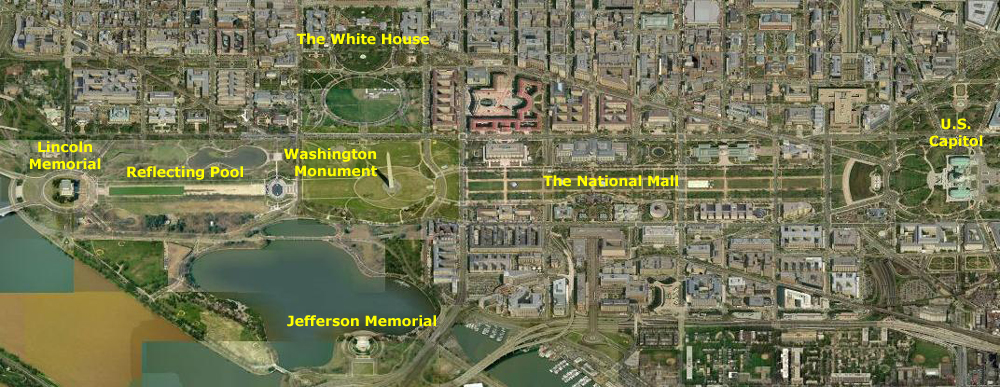 |
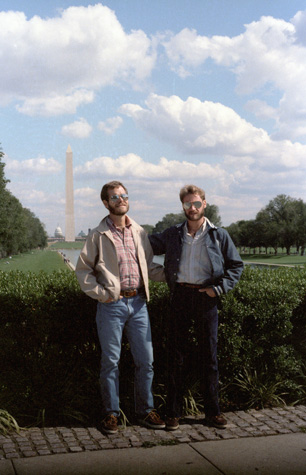 At the West End of the Reflecting Pool |
(Picture at left) This was the first time that Grant had been to Washington, and I enjoyed showing him around the National Mall on this afternoon between my two classes. As I mentioned, Greg happened to be in Washington as well, and so he walked around with us for the afternoon. Greg took this shot which looks from the Lincoln Memorial, down the Mall to the Washington Monument and the Capitol in the background.
(Picture at right)
|
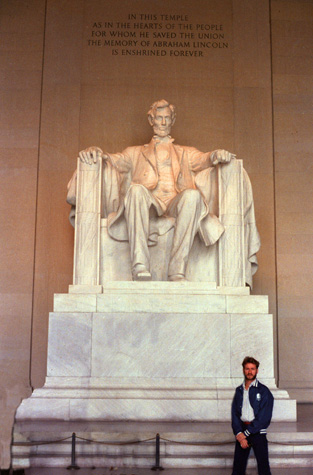 The Lincoln Statue |
The Lincoln Memorial is one of the best known monuments in Washington (and probably one of the best-known ones in the world), and we spent a fair amount of time here.
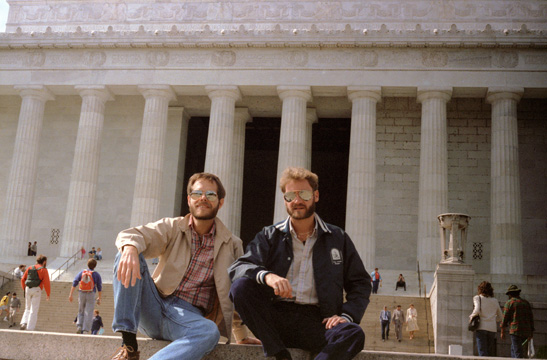 Here is a picture that Greg took of Grant and I in front of the Lincoln Memorial. The weather was good and there were a lot of tourists around. |
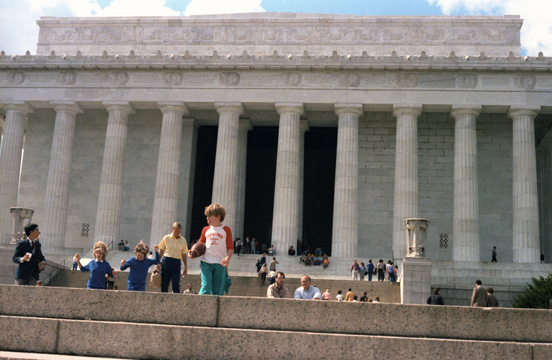 I asked Grant to photograph Greg and I, but he had to move down the steps to get more of the Memorial in. This meant that Greg and I weren't prominent in the picture, although you can see him sitting beside me partway up the steps. |
From the Lincoln Memorial, we walked down the Mall towards the Washington Monument; I wanted to take Grant up in it to set some expansive views of the city below.
|
The original design was by Robert Mills, but he did not include his proposed colonnade due to a lack of funds, proceeding only with a bare obelisk. Despite many proposals to embellish the obelisk, only its original flat top was altered to a pointed marble pyramidion, in 1884. The cornerstone was laid on July 4, 1848; the first stone was laid atop the unfinished stump on August 7, 1880; the capstone was set on December 6, 1884; the completed monument was dedicated on February 21, 1885; and officially opened October 9, 1888. Upon completion, it became the world's tallest structure, a title previously held by the Cologne Cathedral. The monument held this designation until 1889, when the Eiffel Tower was completed in Paris, France.
At left is probably the best of all the pictures I took this afternoon, taken after we actually had left the monument and were walking along the Mall towards the Capitol. A number of the pictures we took this afternoon did not turn out well; my camera seemed to be malfunctioning (and I took it to be cleaned and adjusted the very next week when I returned home to Dallas).
As I mentioned, I wanted to take Grant up in the Monument, and so the three of us waited in line for our turn to take the elevator to the top. There, we spent some time looking out the small windows that gave us views in all directions. I took maybe eight or ten pictures, but due to my camera malfunction (which caused a blackness at a picture's right edge or, even worse, a thick black area obsuring maybe the right third of a picture), only three of them are worth including here.
|
Behind those museums, to the north (left in the picture) are other public buildings, including the National Archives, some Labor and Defense Department buildings, and some buildings associated with the National Library.
In the far background at left is the Supreme Court. The United States Capitol is directly ahead at the end of the Mall; you are, as you may know, actually looking at the "back door" of the Capitol as it was envisioned by Pierre L"Enfant, who thought that the District of Columbia would develop to the east instead of the west. To the right of the Capitol in this picture are the House and Senate office buildings.
Along the right side of the picture (and along the right side of the Mall) are (working forward from the Capitol) the Smithsonian Air and Space Museum, the Hirschorn Museum, and the group of museum buildings collectively referred to as "the Smithsonian".
Elsewhere in my photo album I have other pictures taken from the top of the Washington Monument, so the other two that I want to include here (actually the only other two that turned out well) are not the only ones I have from this vantage point.
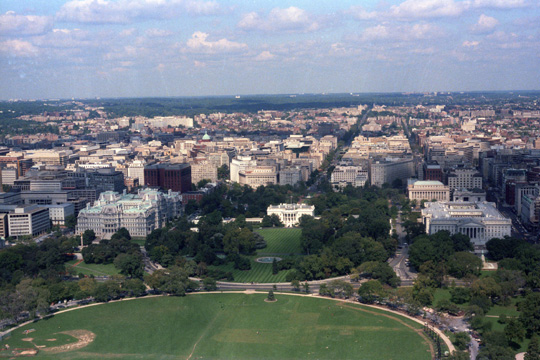 This view, looking north, shows the White House and the Ellipse. The Executive Office Building is the ornate structure at the left, and to the right of the White House is the Treasury Department. Downtown Washington is in the background. |
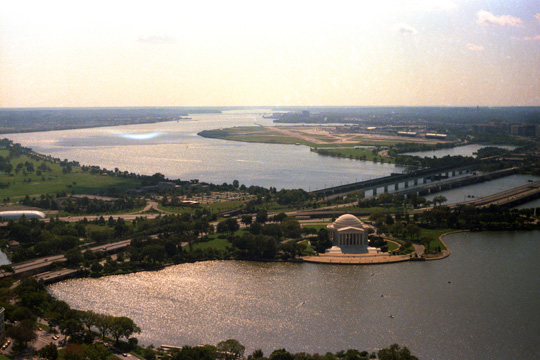 In this view, the Potomac River runs through the picture down to the South. In the foreground is the Jefferson Memorial, behind it is the Fourteenth Street Bridge that leads to Alexandria and Crystal City, and beyond is National Airport- into which Grant flew two days ago. Alexandria is way down the river; you can barely see the buildings along the river at Old Town. |
We spent the rest of the afternoon walking around the Mall with Greg. He eventually left us to meet up with a friend of his and Grant and I returned to the Ramada Inn Old Town. For dinner, we drove down U.S. Highway 1 to Fort Belvoir and picked out a restaurant near the base. I wanted Grant to see where to drop me off tomorrow morning. Grant spent Monday on his own, mostly at the Smithsonian, picking me up after work. I'd booked him and evening flight back to Dallas, so we had a quick dinner and I dropped him at National Airport.
You can use the links below to continue to another photo album page.
 |
September 7, 1987: Sailing on Lake Ray Hubbard |
 |
April 18-19, 1987: A Weekend in Seattle |
 |
Return to the Index for 1987 |